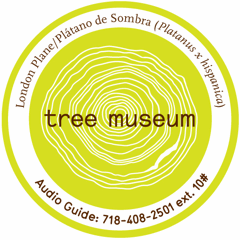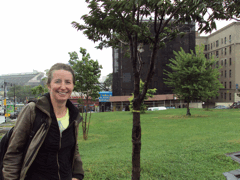A Hundred Bronx Tales
Air Date: Week of November 27, 2009

A 7 inch Tree Museum marker
The Bronx Grand Concourse, a wide, tree-lined boulevard modeled after Paris’ Champs d’Elysées, recently turned 100 years old. For its birthday it got 100 stories about 100 of its most beloved trees. Living on Earth’s Ike Sriskandarajah went to the Bronx to listen to the Tree Museum.
Transcript
YOUNG: The Grand Concourse is a broad, busy thoroughfare running north from Manhattan into the Bronx – and it turns 100 this month. But instead of 100 candles, the concourse has a hundred stories about its most loved trees.
Each story is inspired by a particular tree, and told by some of the Bronx finest – from architects and historians to DJs and beekeepers. It’s called the Tree Museum and Living on Earth’s Ike Sriskandarajah went to check it out.
[Sound of traffic]
SRISKANDARAJAH: On a rainy afternoon I’m in Joyce Kilmer Park standing on an island of green in the heart of the Bronx. To my right, the new and old Yankee stadiums loom over a strip of Popeye’s and Burger Kings. In the corner of the park closest to the stadiums stands a Cherry tree with a green disc pasted to the ground in front of it.
HOLTEN: There’s tree number 21.
SRISKANDARAJAH: Wow, see, I would’ve walked right over that – and, in fact, I did walk right over that.
HOLTEN: Yeah. So they’re kinda of, um, it was tricky… trying to put something out on the streets of New York is really not an easy task.
SRISKANDARAJAH: That’s Katie Holten, she put the neon green disc on the sidewalk and 99 others just like it in front of other trees in the Bronx.
HOLTEN: So this is one of the side walk markers and it’s a seven inch diameter disc that’s basically glued to the sidewalk and it’s right in front of this Cherry tree that’s overlooking the old Yankee stadium. I knew immediately, ok this has to be a Yankee story right here because you’ve got this amazing view. And even the sounds when there’s a game on you can see the fans inside of the stadium and you can hear the roars of the crowd.
[Cheers, baseball hit, flying though the air, landing]
HOLTEN: And so the marker has the name of the tree, Kwanzan Cherry, and so you can dial the number 718-408-2501.
[Dialing the number (7-1-8 4-0-8- 2-5-0-1 dialing sounds)]
HOLTEN: You hear:
[“Welcome to the Tree Museum”]
HOLTEN: You know, the basic introduction.
[Phone: (basic introduction)]
HOLTEN: And then if you press the extension number, with this tree is 21 pound, then you hear that story.
[Extension (2-1 #)]
HOLTEN: And this tree happens to be Bernie Williams who’s…uh, I don’t know if you know Bernie…
WILLIAMS: Hi everyone, this is Bernie Williams. If you look to the west, just a couple of blocks away, you’ll see the side of the old Yankee stadium, where I had the honor and privilege of playing for 16 years, as well as the new stadium where new memories are being created everyday.

A 7 inch Tree Museum marker
SRISKANDARAJAH: There are stories like this at every one of the stops. The Tree Museum is a dynamic delivery of an old story. The history of the borough as told by the people who lived it. The only physical footprint here are the markers that measure the length of the Grand Concourse, a broad boulevard that runs through the Bronx.
[MUSIC]
HOLTEN: You can see how wide it is, you know most of the other streets, it was kind of based on the Champs-Elysees in Paris so it’s got this grandeur.
SRISKANDARAJAH: Katie’s right, though the noise and fumes of passing busses undercut some of that grandeur.
The Grand Concourse was built at the turn of the century at the peak of the city beautiful campaign, a progressive movement that created handsome spaces in urban settings. It wasn’t beauty for beauty’s sake. The idea was that ornate parks and promenades could make every city dweller feel like royalty. The Grand Concourse was the gilded pathway for Manhattanites to convalesce from the grittiness of city life. And it did make people feel better.
HOLTEN: This was one of the special things about the Bronx was that it was a green place, that it was a getaway from the city. Manhattan was crowded, polluted, filthy, so people would get sick and they’d leave to come up here to get the fresh air. So, it’s really ironic, that they come up here to get away from it all and recover.
SRISKANDARAJAH: Standing at 165th Street it’s impossible to imagine, but 100 years ago the Bronx was all pasture.
HOLTEN: The project really came alive once I went to the archives and saw the photographs, and I got goose bumps because it looked like the fields around my mom’s house in Ireland – green, trees in the distance – but basically the area was all farmland, and that’s where it got its name, Jonas Bronx was a farmer.

DSC15 Katie Holten stands next to a Tree #21 in Joyce Kilmer Park.
SRISKANDARAJAH: And Katie wanted to remind people that despite the trash facilities, and despite the gangs and arson that have plagued the Bronx, the borough has clung onto some of its roots, as I learned when I dialed tree number two.
[Phone extension 2-#]
WOMAN 1: Hey, if you look southbound, right across the street, you’ll see our South Bronx urban farm. That’s right, an urban farm in the Bronx! How cool is that? We are bringing farmland back to our borough”.
SRISKANDARAJAH: So over two years, Katie had hundreds of Bronxites call in by telephone. And through those stories, she turned the four and a half miles of the Grand Concourse, in a trip through time. If you start at tree number one at 138th street down at Deacon Rock you’ll hear that the Jonas Bronx quietness.
MAN 1: “Deacon rock park. Quiet ponds. Quieter at the off ramp.”
SRISKANDARAJAH: Bronx contemporary life, like the Puerto Rican drummers at tree number 27…
[Drumming through phone]
SRISKANDARAJAH: At tree 50, an early hip-hop DJ…
MAN 2: “You know the Bronx, back in my gang days we did a lot of running up and down this area, right here on the cross Bronx expressway. I spent a lot of time in traffic. So, it’s fitting that my tree would be dedicated on this spot right here, as we speak.”
SRISKANDARAJAH: A 95-year-old woman remembers when the concourse was young.
WOMAN 2: “As a little girl, in the 1920s, my father took me to the Grand Concourse to visit a tree that had been planted in honor of his brother, Jack, who died in World War One and thought it was a great way to honor his service and his life.”
SRISKANDARAJAH: When the Concourse was opened up in 1909, the trees which lined it were stars. Now, they are largely hidden in plain sight. But the Tree Museum and its stories lift these giants from the urban jungle. And the diversity of stories matches the diversity of nature.
HOLTEN: Norway Maple, Red Maple, Northern Red Oak, Pin Oak, Ailanthus, Green Ash, Crabapple, Chinese Elm, Hawthorn, Little Leaf Linden, Sophora and Sambuca.
[Phone number tones]
SRISKANDARAJAH: For Living on Earth, I’m Ike Sriskandarajah in the Bronx, New York.
[Phone hangs up]
Links
Hear more about how to you can listen, talk and even text to the trees at
Living on Earth wants to hear from you!
Living on Earth
62 Calef Highway, Suite 212
Lee, NH 03861
Telephone: 617-287-4121
E-mail: comments@loe.org
Newsletter [Click here]
Donate to Living on Earth!
Living on Earth is an independent media program and relies entirely on contributions from listeners and institutions supporting public service. Please donate now to preserve an independent environmental voice.
NewsletterLiving on Earth offers a weekly delivery of the show's rundown to your mailbox. Sign up for our newsletter today!
 Sailors For The Sea: Be the change you want to sea.
Sailors For The Sea: Be the change you want to sea.
 Creating positive outcomes for future generations.
Creating positive outcomes for future generations.
 Innovating to make the world a better, more sustainable place to live. Listen to the race to 9 billion
Innovating to make the world a better, more sustainable place to live. Listen to the race to 9 billion
 The Grantham Foundation for the Protection of the Environment: Committed to protecting and improving the health of the global environment.
The Grantham Foundation for the Protection of the Environment: Committed to protecting and improving the health of the global environment.
 Contribute to Living on Earth and receive, as our gift to you, an archival print of one of Mark Seth Lender's extraordinary wildlife photographs. Follow the link to see Mark's current collection of photographs.
Contribute to Living on Earth and receive, as our gift to you, an archival print of one of Mark Seth Lender's extraordinary wildlife photographs. Follow the link to see Mark's current collection of photographs.
 Buy a signed copy of Mark Seth Lender's book Smeagull the Seagull & support Living on Earth
Buy a signed copy of Mark Seth Lender's book Smeagull the Seagull & support Living on Earth

